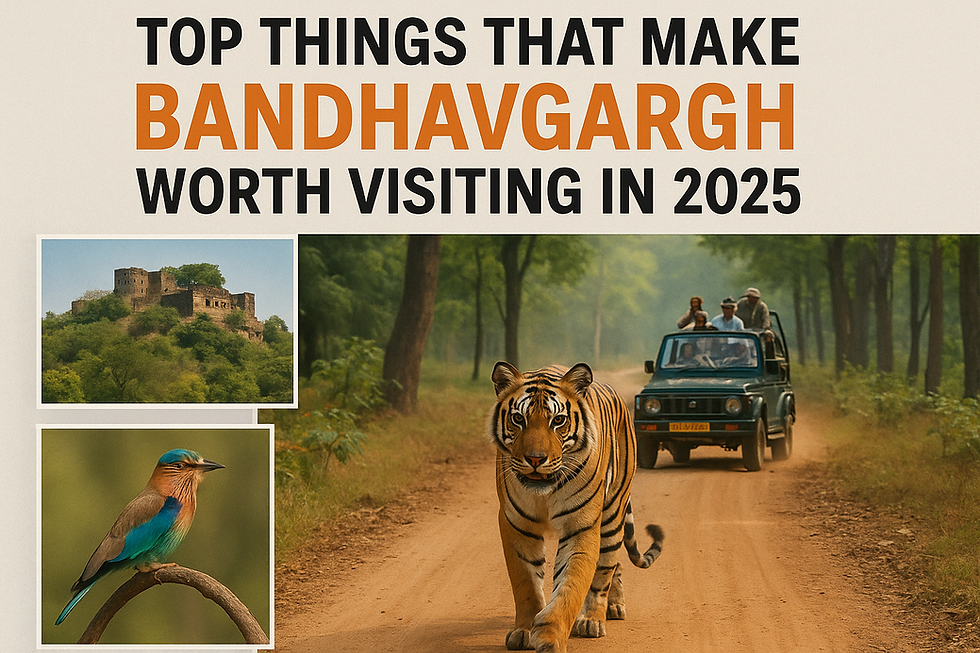Tiger Safari in Bandhavgarh: Photography Secrets for Stunning Shots
- Kings Lodge
- Sep 15, 2025
- 4 min read

A tiger safari in Bandhavgarh is one of the most exciting wildlife experiences in India. Picture the early morning light filtering through dense forests, the quiet hum of your jeep, and a Bengal tiger stepping into view. Capturing this incredible moment on camera is a dream for many travelers. With the right preparation and tips, you can take photos that truly reflect the magic of Bandhavgarh.
This guide shares everything you need to know from the best times for tiger sighting to essential gear, camera settings, and ethical practices. Whether you’re using a smartphone or a professional camera, these secrets will help you bring home stunning shots.
Why Bandhavgarh Is Perfect for Tiger Photography
Bandhavgarh National Park in Madhya Pradesh has one of the highest densities of Bengal tigers, making it a top destination for wildlife photographers. The park’s mix of grasslands, sal forests, and ancient ruins creates diverse and dramatic backdrops. Alongside tigers, you may also see leopards, sloth bears, deer, and many bird species. The variety of wildlife and landscapes makes every safari exciting and full of opportunities.
Best Time for Tiger Sightings
Timing can make or break your photography experience:
Season:
Winter (November–February) brings cool weather, misty mornings, and soft sunlight.
Summer (March–June) offers high chances of tigers near waterholes but can be very hot.
Time of Day:
Morning safaris provide soft light and active wildlife.
Afternoon safaris offer warm golden tones perfect for dramatic images.
Multiple Drives:
Book more than one safari to increase your chances of a sighting. Tigers are unpredictable, and patience is key.
Choosing the Right Safari Zone
Bandhavgarh has several safari zones: Tala, Magadhi, Khitauli, and Panpatha. Tala Zone is the most popular for tiger sightings and offers scenic views of old ruins. Magadhi and Khitauli are less crowded but still excellent for photography. Book in advance, especially for Tala, as slots fill quickly.
Essential Photography Gear
You don’t need professional equipment, but the right tools will improve your photos:
Cameras and Lenses:
A DSLR or mirrorless camera with a 200–400 mm telephoto lens is ideal.
A wide-angle lens (18–55 mm) works well for landscapes and ruins.
For Smartphones:
Use Pro or Manual mode for more control.
Carry a small stabilizer or tripod for steady shots.
Other Must-Haves:
Extra batteries and memory cards.
A beanbag or monopod to steady your camera in the jeep.
A dustproof bag to protect your gear on bumpy tracks.
Secrets for Stunning Shots
1. Use Natural Light Wisely
Morning light is soft and flattering, while afternoon light adds warmth and drama. Avoid harsh midday sun unless you’re using it for creative high-contrast effects.
2. Focus on the Eyes
Sharp eyes make your photos powerful. Even if the background is slightly blurred, clear eyes connect the viewer to the subject.
3. Apply the Rule of Thirds
Position the tiger slightly off-center for a more dynamic and balanced composition.
4. Capture Behavior
Look for moments that tell a story: a tiger drinking, yawning, or walking through the forest. These action shots are more engaging than simple portraits.
5. Include the Landscape
Bandhavgarh’s meadows, cliffs, and ancient structures are part of its charm. Wide shots showing a tiger in its environment can be breathtaking.
6. Be Patient and Ready
Tigers may remain hidden for long periods. Keep your camera on and your settings ready so you don’t miss the moment when one appears.
Camera Settings Guide
Shutter Speed: Use 1/1000 or faster for moving subjects.
Aperture: Choose f/4–f/5.6 to blur the background.
ISO: Keep it low (100–400) for less noise but raise it in low light.
Burst Mode: Use continuous shooting to capture multiple frames.
Smartphone Photography Tips
Use HDR mode to balance highlights and shadows.
Avoid digital zoom—move closer instead.
Keep your lens clean to prevent smudges.
Lightly edit afterward for natural colors and contrast.
Ethical Wildlife Photography
Respecting the park and its animals ensures a safe and rewarding experience:
Stay quiet and avoid sudden movements.
Never use flash—it can disturb wildlife.
Keep a safe distance and do not pressure your driver to get too close.
Follow all park rules and your guide’s instructions.
Planning Your Visit
Book Early: Popular months and zones fill up quickly.
Stay Nearby: Choosing a good resort in Bandhavgarh makes early starts easier and provides access to local guides and naturalists.
Dress Appropriately: Wear earthy tones like brown, green, or beige to blend in.
Carry Essentials: Bring water, light snacks, sunscreen, and a hat for comfort.
More Photography Opportunities
Tigers are the main attraction, but Bandhavgarh offers more:
Birdlife: Peacocks, kingfishers, and eagles are common.
Other Wildlife: Leopards, sloth bears, and various deer species add variety.
Landscapes: Ancient statues, Bandhavgarh Fort, and open meadows create dramatic frames.
Editing Tips
Use software like Lightroom or Snapseed for simple adjustments.
Focus on improving brightness, contrast, and sharpness without over-editing.
Crop only when necessary—compose carefully while shooting.
Final Thoughts
A tiger safari in Bandhavgarh offers unforgettable encounters with India’s wildlife. With patience, preparation, and respect for nature, you can create photos that capture not just a tiger’s beauty but the spirit of the jungle itself. Plan multiple safaris, choose the right gear, and let the forest guide your creativity. Every shot you take will be more than a picture, it will be a story of your adventure in Bandhavgarh’s wild heart.




Comments